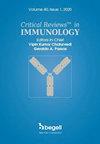Identification of a Novel Five-Gene Prognostic Model for Laryngeal Cancer Associated with Mitophagy Using Integrated Bioinformatics Analysis and Experimental Verification
IF 0.9
4区 医学
Q4 IMMUNOLOGY
引用次数: 0
Abstract
Laryngeal cancer (LC) is a prevailing tumor with a high mortality rate. The pivotal role of mitophagy in LC is acknowledged; however, a comprehensive analysis of the corresponding genes has not been conducted. In the present study, we proposed a prognostic model consisting of mitophagy-related genes in LC. Clinical information and transcriptome profiling of patients with LC and mitophagy-related genes were retrieved from open-source databases. Gene set variation analysis (GSVA) and Weighted Gene Co-expression Network Analysis (WGCNA) were used to identify core mitophagy-related genes and construct gene co-expression networks. Functional enrichment analysis was employed to analyze the enriched regulatory pathways of the mitophagy-related genes. Kaplan-Meier curves (KM), Cox, and LASSO regression were applied to explore their prognostic effects. Finally, quantitative real-time PCR (RT-qPCR) further verified the bioinformatics prediction. A total of 45 genes related to mitochondrial pathways was collected. GSVA analysis demonstrated that these genes in tumor samples mainly referred to the mitochondrial pathway. Among these genes, five mitophagy-related-gene signatures (CERCAM, CHPF, EPHX3, EXT2, and MED15) were further identified to construct the prognostic model. KM and Cox regression analyses indicated that this model had an accurate prognostic prediction for LC. RT-qPCR showed that CERCAM, CHPF, EXT2, and MED15 expression were upregulated, and EPHX3 level was decreased in LC cells. The present study established a five-mitophagy-related-gene model that can predict the prognosis of LC patients, thus laying the foundation for a better understanding and potential advancements in clinical treatments for LC.利用综合生物信息学分析和实验验证确定与丝裂噬相关的喉癌五基因预测模型
喉癌(LC)是一种死亡率很高的常见肿瘤。有丝分裂在喉癌中的关键作用已得到公认,但尚未对相应基因进行全面分析。在本研究中,我们提出了一个由 LC 中有丝分裂相关基因组成的预后模型。我们从开源数据库中检索了 LC 患者的临床信息和转录组图谱,以及有丝分裂相关基因。利用基因组变异分析(GSVA)和加权基因共表达网络分析(WGCNA)确定有丝分裂相关的核心基因并构建基因共表达网络。功能富集分析用于分析有丝分裂相关基因的富集调控通路。应用Kaplan-Meier曲线(KM)、Cox和LASSO回归来探讨它们的预后效应。最后,实时定量 PCR(RT-qPCR)进一步验证了生物信息学预测。研究共收集了 45 个与线粒体通路相关的基因。GSVA分析表明,肿瘤样本中的这些基因主要涉及线粒体通路。在这些基因中,进一步确定了五个与线粒体吞噬相关的基因特征(CERCAM、CHPF、EPHX3、EXT2 和 MED15),以构建预后模型。KM和Cox回归分析表明,该模型能准确预测LC的预后。RT-qPCR显示,LC细胞中CERCAM、CHPF、EXT2和MED15表达上调,EPHX3水平下降。本研究建立了一个可预测LC患者预后的五种嗜丝虫相关基因模型,从而为更好地理解LC并推进其临床治疗奠定了基础。
本文章由计算机程序翻译,如有差异,请以英文原文为准。
求助全文
约1分钟内获得全文
求助全文
来源期刊
CiteScore
2.60
自引率
0.00%
发文量
14
审稿时长
>12 weeks
期刊介绍:
Immunology covers a broad spectrum of investigations at the genes, molecular, cellular, organ and system levels to reveal defense mechanisms against pathogens as well as protection against tumors and autoimmune diseases. The great advances in immunology in recent years make this field one of the most dynamic and rapidly growing in medical sciences. Critical ReviewsTM in Immunology (CRI) seeks to present a balanced overview of contemporary adaptive and innate immune responses related to autoimmunity, tumor, microbe, transplantation, neuroimmunology, immune regulation and immunotherapy from basic to translational aspects in health and disease. The articles that appear in CRI are mostly obtained by invitations to active investigators. But the journal will also consider proposals from the scientific community. Interested investigators should send their inquiries to the editor before submitting a manuscript.

 求助内容:
求助内容: 应助结果提醒方式:
应助结果提醒方式:


